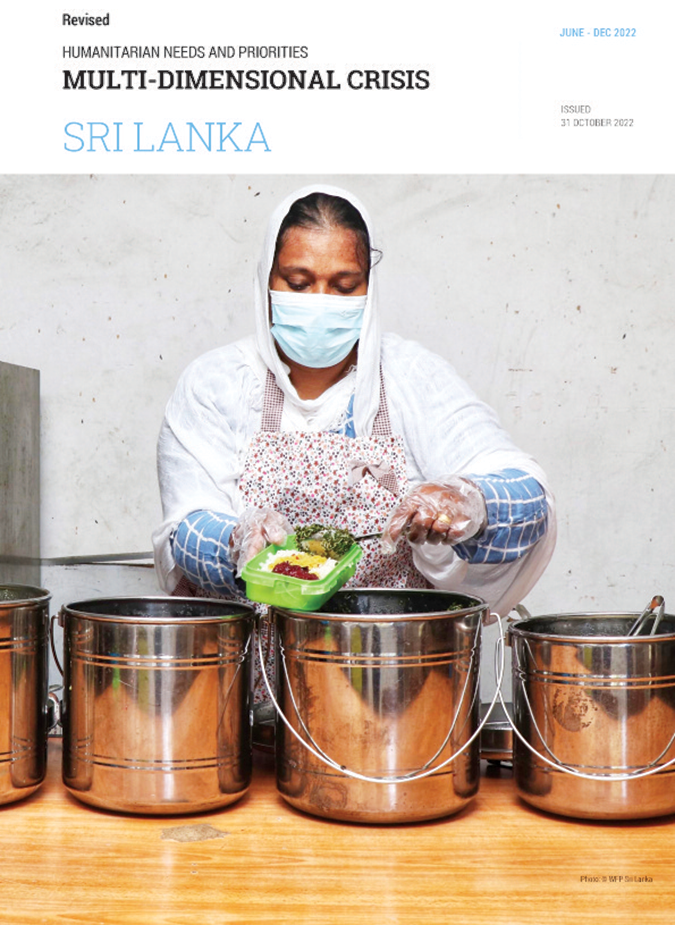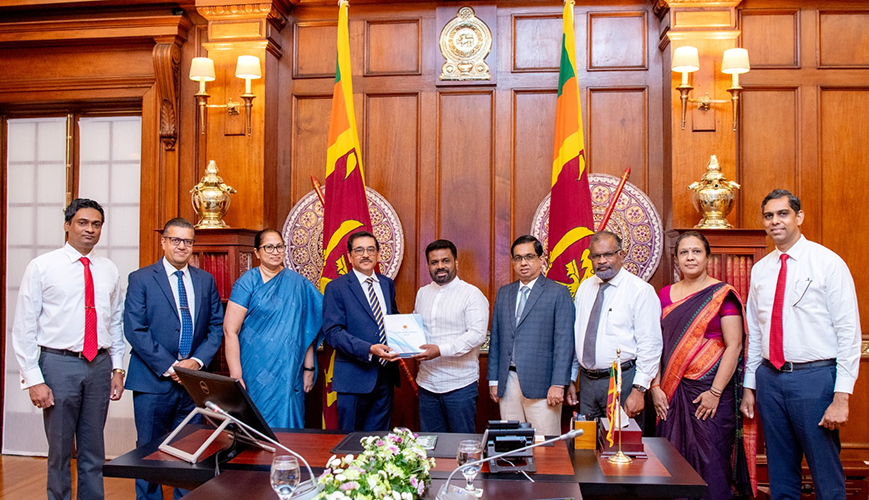News
‘Lankan food crisis is taking a turn for the worse’

More than one half of Sri Lanka’s population, currently making use of food-based coping strategies and livelihood coping strategies since they do not have enough food or money to buy food, are likely to “resort to means that will have a higher negative impact on their medium long-term capacity to generate income,” says a UN report.
The report, titled ‘Sri Lanka: Multi-dimensional crisis -Humanitarian needs and priorities JUNE – DEC 2022’ by the United Nations Office for the Coordination of Humanitarian Affairs (OCHA) on behalf of Humanitarian Country Team and partners, says that an estimated 13.5 million, or 61.1 per cent of the population, are using food-based coping strategies, and 47.7 per cent of households use livelihood coping strategies.
The food and livelihood coping strategies being adopted in response to the situation by the Lankans include cutting the number of meals consumed in a day, reducing meal sizes, spending savings, and purchasing food on credit, says the report originally published on Nov 8, 2022.
“About 5.3 million people, or 24 per cent of population, are reducing the number of meals, and the same percentage of the population are reducing adults’ consumption so that children can eat, with women being the last to eat in the household. The proportion of households with unacceptable diets is ten times higher compared to the end of 2021. About 8.7 million people in the country are reported as not consuming adequate diets; nearly 32.2 per cent of these households are in urban areas. The livelihood-based coping strategies that households are resorting to include spending savings, selling productive assets, reducing essential healthcare expenses, withdrawing kids from school, buying food on credit, borrowing money or pawning jewels. Once these least severe strategies are exhausted, households would likely resort to means that will have a higher negative impact on their medium long-term capacity to generate income and their food security. Informal income earners, unskilled casual laborers, and those who do not have home gardens or livestock are among the most vulnerable to food insecurity,” says the report.
It says: With the reduction in domestic agricultural production during the Yala 2022 season, the prices of food are expected to increase further and reliance on imported food will intensify. This, in turn, would continue to drive a severe reduction of food availability and food access, with negative effects on food and nutrition security during the upcoming lean season, which starts in October 2022. Unless there is a significant turnaround on field cultivation and intensified agricultural support is mobilized, the upcoming Maha 2022/2023 season will remain a challenge. Without a solid domestic production base, food insecurity will likely continue and those who will suffer the most are the poor and already vulnerable families.
“Prices of most commodities have increased considerably since the end of 2021, and food inflation was measured at 94.9 per cent in September 2022 compared to a year before, a further increase from 93.7 per cent in August. Based on the recently concluded Crop and Food Security Assessment Mission by WFP and FAO, nationally, 6.3 million people, or 28 per cent of the population, are found to be moderately or severely food insecure. Of particular concern are 66,000 people who are severely acute food insecure, 18,000 of whom are living in the estate sector such as tea plantations. In total, 57.1 per cent of severely insecure people in the country are in the estate sector, and 41.6 per cent in the Central Province. Characteristics most strongly associated with moderately food insecure households include female-headed households (at 39.8 per cent), heads of household with no education (at 43.1 per cent), households of Indian Tamil ethnicity (at 50.3 per cent) and beneficiaries of the Samurdi programme (at 41.3 per cent). A slightly different set of characteristics are associated with severe acute food insecurity, which include the estate sector (at 2 per cent), high dependency ratio11 (at 2.3 per cent), “assistance” as the main source of income (at 1.4 per cent) and having at least one member living in the household with a disability12 (at 1.2 per cent).”
Business
Central Bank Presents Annual Economic Review 2024 to President

The Central Bank of Sri Lanka today (07) presented its flagship publication, the Annual Economic Review for 2024 (AER 2024), to President and Minister of Finance, Anura Kumara Disanayake, highlighting the steady progress of Sri Lanka’s economic recovery following the country’s most severe downturn in recent history.
The report was officially handed over by Dr. P. Nandalal Weerasinghe, Governor of the Central Bank, during a special ceremony held at the Presidential Secretariat.
AER 2024 comprises four main chapters: Macroeconomic Developments, Conditions of the Financial System, Review of Central Bank’s Policies and Macroeconomic Outlook.
According to the Review, the Sri Lankan economy showed significant signs of recovery in 2024, following the deep economic crisis experienced two years ago. The recovery trajectory, though challenging, has been notably faster than that of many other debt-distressed countries.
Improvements in economic activity, a partial resurgence in purchasing power and reduced uncertainty are among the key positive indicators noted in the report.
The event was attended by Dr. Nandika Sanath Kumanayake, Secretary to the President, K. M. Mahinda Siriwardena, Secretary to the Treasury, Mrs. K. M. A. N. Daulagala, Senior Deputy Governor, Dr. C. Amarasekara, Assistant Governor, Dr. (Mrs.) S. Jegajeevan, Director of Economic Research and Dr. L. R. C. Pathberiya and Additional Director of Economic Research at the Central Bank Dr. V. D. Wickramarachchi.
[PMD]
Latest News
The sun will be directly overhead Colombo, Awissawella, Talawakelle, Dimbula, Galakumbura and Dambagalla at about 12:12 noon today [07]

On the apparent northward relative motion of the sun, it is going to be directly over the latitudes of Sri Lanka during 05th to 14th of April in this year.
The nearest areas of Sri Lanka over which the sun is overhead today (07th) are Colombo, Awissawella, Talawakelle, Dimbula, Galakumbura and Dambagalla at about 12:12 noon.
News
MoU on Defence a significant new addition to Ranil-Modi consensus

Defence Secy says a decision was taken at 2023 Defence Dialogue
Contrary to claims that the MoU/agreements finalised during Indian Prime Minister Narendra Modi’s state visit here were in accordance with an understanding between former President Ranil Wickremesinghe and PM Modi in July 21, 2023, the MoU on Defence Cooperation is a new addition.
A joint statement issued on July 21, 2023, soon after the conclusion of Wickremesinghe’s visit, didn’t refer to an MoU on defence cooperation.
Premier Modi disclosed the decision to enter into an MoU on 16 Dec., 2024 at a joint press conference addressed by him and President Anura Kumara Dissanayake.
A media statement issued by the Indian High Commission in Colombo quoted the Indian PM as having said that President Dissanayake and he had agreed that the two countries’ security interests were interconnected. “We have decided to quickly finalise the Security Cooperation Agreement.”
President Dissanayake, in his address, didn’t refer to the proposed MoU on defence cooperation. The Presidential Media Division quoted President Dissanayake as having said that they exchanged views on cooperation in the fields of defence and security, power and energy, training and capacity building, education, agriculture and social security.
However, retired Air Vice Marshal Sampath Thuyakonttha, who signed the MoU on Defence Cooperation, in his capacity as the Defence Secretary, said that they had agreed to strengthen defence relations through an MoU during Defence Dialogue in 2023.
Responding to concerns expressed in some quarters about the MoU at issue, Thuyakonttha, a veteran Mi 24 helicopter gunship pilot, emphasised that the agreement on the MoU had been reached in keeping with the instructions issued by the Secretary to the President in January this year.
In addition to the MoU on Defence Cooperation, the two sides finalised six other MoUs/agreements. They dealt with Implementation of HDVC interconnection for import/export of power, cooperation in the field of sharing successful digital solutions implemented at population scale for digital transformation, multi-sectoral grant assistance for Eastern Province, cooperation in the field of health, medicine, etc.
India, Sri Lanka and UAE have agreed to develop Trincomalee as an energy hub.
Milinda Moragoda, who served as Sri Lanka’s High Commissioner in New Delhi during the August 2021-Oct 2023 period and played a critical role in negotiations, stressed the pivotal importance of going ahead with the MoU/agreements.
In response to The Island queries regarding the latest developments, Moragoda said that the progress made on the economic integration and connectivity side was extremely encouraging. Especially, the concrete steps taken to establish connectivity in power, petroleum and the development of Trincomalee as an energy hub, he said.
“The fact that trilateral cooperation between India, Sri Lanka and selected third countries will become part of our future development strategy, with the formal entry of the UAE as a partner in the Trincomalee energy hub initiative is a very important step forward.”
Moragoda said: “The establishment of a framework to share successful digital solutions between India and Sri Lanka is also another positive development.
“It is critical that both parties now focus on the speedy implementation of all the agreements that have been reached.
“Future consideration should be given to developing road and rail connectivity as well.
“We should all understand and absorb that the physical connectivity that would be established in power, petroleum and other sectors will link us directly to India, the Middle East and Europe making us potentially a key global hub at a pivotal point in world history.
“The understandings that have been reached with India could become critical for Sri Lanka’s immediate economic survival and development as we cope with the monumental disruptions taking place in the international economic environment and geopolitical sphere at the moment.
“Sri Lanka is in an extremely vulnerable position and will have to very quickly work out a survival strategy through which we can diversify our foreign income and investment sources while arriving at an understanding with the US in the short term.
“As we enter an era where geoeconomics will become more important than plain economics, the agreements reached during the visit of Prime Minister Modi could help lay an initial foundation for Sri Lanka’s future developmental direction.”
By Shamindra Ferdinando
-

 Features1 day ago
Features1 day agoStarlink in the Global South
-

 Business2 days ago
Business2 days agoDaraz Sri Lanka ushers in the New Year with 4.4 Avurudu Wasi Pro Max – Sri Lanka’s biggest online Avurudu sale
-

 Business3 days ago
Business3 days agoStrengthening SDG integration into provincial planning and development process
-

 Business2 days ago
Business2 days agoNew SL Sovereign Bonds win foreign investor confidence
-

 Sports4 days ago
Sports4 days agoTo play or not to play is Richmond’s decision
-

 Business11 hours ago
Business11 hours agoColombo Coffee wins coveted management awards
-

 Features1 day ago
Features1 day agoModi’s Sri Lanka Sojourn
-

 Latest News6 days ago
Latest News6 days agoIPL 2025: Rookies Ashwani and Rickelton lead Mumbai Indians to first win











